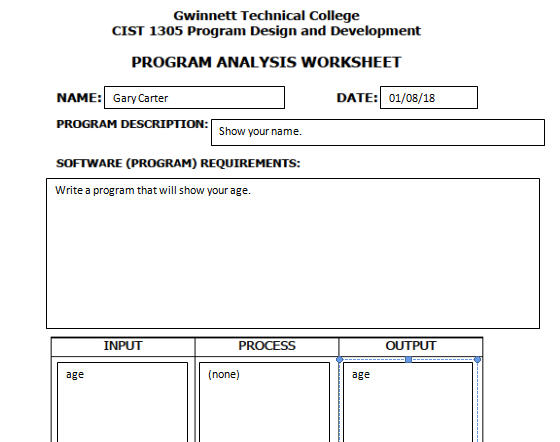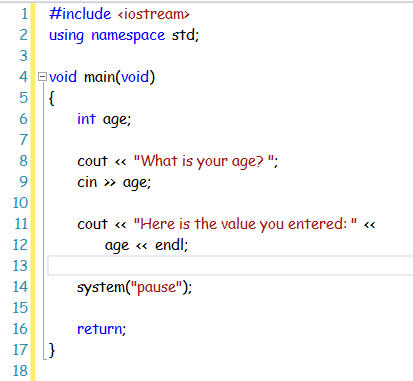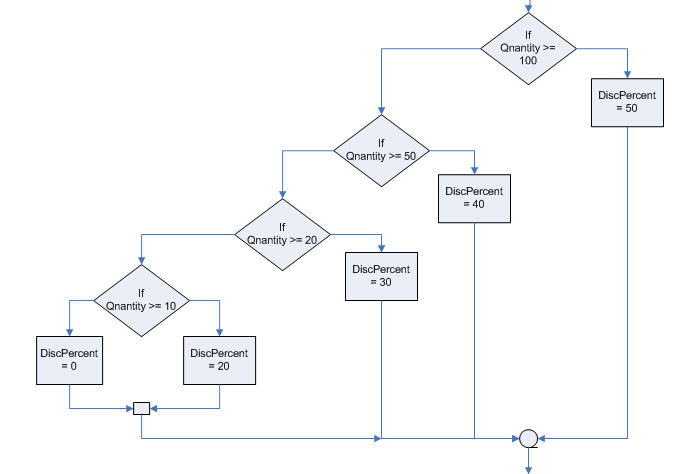
Carter's Castle
Carter's Online Class with PDD Demos and Real Code Demos
Objectives: I will be using this site to help with demonstrations for my programming classes as well as any illustrations I am using for Programer Tutoring. Since most of what I teach is related to Program Design and Development plus Intro to C++ that is where I will start. Then my plans will be to include demonstrations using JAVA with maybe some Visual Basic after all this is up and running. In the end I would like to include some PHP. Hope this will help you in your studies of programming and set you on path to much success.
Each item has a menu pick across the top as tab navigators. These topics will be covered by hitting highlights I have found important and then covering programming assignment demos that get into the details of that particular coding technique. I truely believe that if you practice and grow with your efforts you can master the programming skill. Some people can tell right off if they like programming. Some people need a little more time using tools and techniques to help work them into a focused coder. If you benefit from this site or see inprovements you could recommend feel free to email me at objectcoach@aol.com. In the beginning there will be areas that have (UNDER CONSTRUCTION / FUTURE CONTENT YET TO COME). One of my goals will be to have this site complete by the end 2018.
If you are just starting to use Carter's Castle Site please go to the last page (on the menu bar labeled Survey) and complete the survey. The intent is to determine where a participant is coming from. Are you a student? Have you programmed? and other such questions. Make sure you click check answers and then do the email score. Remember, this is not a test score it is only for survey information.
Brief Video Intro
A Quick Raptor Demo
Five Steps To Design
Writing Modular Programs
If Statements (Decision Structures)
Loops (Repetition Structures)
Files
Arrays
If you can master the above list of programming skills then you should be able to make a living as a programmer. Why don't you give it a try, then email me on how things turned out. My general email account is objectcoach@aol.com.
Where does the Castle come from?
When did I start using a computer?
The textbook you might be using
Preparing for your first computer program
What you can expect from this training site?
Print Chart
IPO Chart
Hierarchy Chart
Pseudo Code
Flowchart
Use the next link and take a look at the Flash Cards, The Matching, Crossword Puzzle or the Quiz to see how ready you are. If you do really well you might skip the introductory chapter.
Link: Chapter 1 Review
If you are really energetic you might want to try this quiz.
Link: Chapter 1 Quiz
I really appreciate feedback from people who use my site. Each time you complete a subject from the top it would be great if you could go to the last topic across the top called (Survey). Complete the survey quiz and then send the email request. Thank you for your help.
Starting Out With C++, Tony Gaddis, Chapter 2 - Ocean Levels
Objectives: As a beginning program to write I pulled this problem out of the C++ book but it can easily be used as a program for our Flow Charting class. See if you can look this one over and write your own solution. I will add my suggestions below.
Assuming the ocean's level is currently rising at about 1.5 millimeters per year, write a program that display
If this is your first problem to attempt you might want to review the solution videos first and then make your attempt after you have an idea about the requirements. The end result should be you having a Raptor solution that runs just like the demo.
Part I - Analyze The Project
Part II - Output Design
Part III - IPO Chart & Flowchart using Raptor
Part IV - Demo using Flowgorithm
(underconstructions: add video here when ready)
No quiz for this section.


I really appreciate feedback from people who use my site. Each time you complete a subject from the top it would be great if you could go to the last topic (Survey),complete the survey quiz and then send the email request. Thank you for your help.
This section is usually from a Chapter 2 textbook content section. Take a look at the study helps and quiz to see if you need to spend some time here. If you are not an experienced programmer you may find some items you should spend extra time studying. Once you feel you have mastered this section you should be ready for our next topic of Modules. Modular programming is one of my favorite topics.
Link: Chapter 2 Review
If you are really energetic you might want to try this quiz.
Link: Chapter 2 Quiz
1) Understand the program
2) Determine steps to perform the task






I really appreciate feedback from people who use my site. Each time you complete a subject from the top it would be great if you could go to the last topic (Survey),complete the survey quiz and then send the email request. Thank you for your help.
This section is usually from a Chapter 3 textbook content section. Take a look at the study helps and quiz to see if you need to spend some time here. If you are not an experienced programmer trained in a formal classroom setting you may find some items you should spend extra time studying. Once you feel you have mastered this section you should be ready for our topic of Modular Programs. Setting up good modular programs can be one of my favorite parts in program development. This is a great reason to use a tool like Raptor.
Link: Chapter 3 Review
If you are really energetic you might want to try this quiz.
Link: Chapter 3 Quiz
(after watching the intro video you might want to scroll to the bottom of this page to watch an example of program modules)
A modular program is a program that was developed grouping statements that perform similar (specific) tasks together. Each module in a program can contain a few lines of code or may include several lines of code depending on how broad you define the operation being performed.
1) A simple procedure (might be called a subchart).
2) A formal procedure.
3) A function.
4) A method.
Raptor allows what module types?
1) Demo Raptor using 3 modules to show how modules can operate with a global approach to variables.
2) Demo Raptor using modules that are passed values to accomplish a specific task.
I really appreciate feedback from people who use my site. Each time you complete a subject from the top it would be great if you could go to the last topic (Survey),complete the survey quiz and then send the email request. Thank you for your help.
This section is usually from a Chapter 4 textbook content section. Take a look at the study helps and quiz to see if you need to spend some time here. If you are not an experienced programmer trained in a formal classroom setting you may find some items you should spend extra time studying. Once you feel you have mastered this section you should be ready for our next topic of Decisions. Setting up good decision programs can be one area I struggle with. This is a great reason to use a tool like Raptor.
Link: Chapter 4 Review
If you are really energetic you might want to try this quiz.
Link: Chapter 4 Quiz
Objectives:
The Decision Structure is going to help you give versatility to your program. You will be able to direct instruction to execute some commands and skip others. It is almost like a program that can think. Let's see what we can build.
Color Mixer Project:
We are going to take a look a project from the Gaddis, Program Design & Development book (Chap 4). This project is also in the Gaddis C++ text (Chap 4). Take a look at the project assignment and see what you can do with it. I will review the project requirement first, making some highlights. Then I will look at a very simple Program Analysis Worksheet along with a Hierarch Chart. Finally I will give a 2 part review of an acceptable flowchart. Try your effort first and then watch the videos would be my recommendation.
Analyzing a project is where the wheels start turning. This looks like a very simple project when you first take a look. Then you might consider whether there is a good way and a not so good way to approach the solution. See what you think.
Designing a program may not start out so exciting. Many people want to skip the initial planning. To get this going right you may need to force your effort into the planning stage rather than jump right into trying to build a program.
The first segment covering the flowchart is a partial item where I will get things started (Part 1). If you have not started you might want to watch this piece on Raptor and then give it your best effort. Wait on watching Parts 2 and 3 till you have at least tried Part 1. Then you could determine if clean-up is needed when you move forward.
(for flowchart demo videos you might want to enlarge to full screen)
Part 1
Part 2
Part 3
I really appreciate feedback from people who use my site. Each time you complete a subject from the top it would be great if you could go to the last topic (Survey),complete the survey quiz and then send the email request. Thank you for your help.
Sometimes you will find this to be the most difficult part of your programming effort. I have taken a problem that has some difficulty and will walk through the work required to break it down into more managable parts. Check it out and see if you can follow the design well enough to create a program.
Link to Software Sales (An Advanced Project) - (Click here to proceed)
 Quick look at our project (Chapter 4 Ex 7)
Quick look at our project (Chapter 4 Ex 7)
I really appreciate feedback from people who use my site. Each time you complete a subject from the top it would be great if you could go to the last topic (Survey),complete the survey quiz and then send the email request. Thank you for your help.
This section is usually from a Chapter 5 textbook content section. Take a look at the study helps and quiz to see if you need to spend some time here. If you are not an experienced programmer trained in a formal classroom setting you may find some items you should spend extra time studying. Once you feel you have mastered this section you should be ready for our next topic of Repetition. Setting up a good Repetition Structure can increase the functionality of your program. This is another great reason to use a tool like Raptor.
Link: Chapter 5 Review
If you are really energetic you might want to try this quiz.
Link: Chapter 5 Quiz
One of the most important things you can do with your computer is to repeat an action. We have several ways to describe this process.
Let's talk about a few of the highlights:
Look over your study text and get familiar with this terminology. Then we will attempt a couple of exercises.
If you are using the text from Tony Gaddis then you can follow along with me (Chapter 5 Programming Exercise #1). I going to solve the Bug Collector project with the help of our author's video note. Try to watch this first and then see if you can get the same solution I do. I will follow the Gaddis example and use Raptor to give me a runable flowchart.
Now let's complete one from scratch. This one is also from the Tony Gaddis chapter on Repition (Chapter 5 Programming Exercise #4).
1) Look over the project.
2) You may want to stop here and see if you can come up with a solution on your own.
3) Review over Carter's version of a Program Analysis Worksheet
4) Solve the problem using Raptor
I really appreciate feedback from people who use my site. Each time you complete a subject from the top it would be great if you could go to the last topic (Survey),complete the survey quiz and then send the email request. Thank you for your help.
This section is usually from a later chapter in your textbook called Arrays. Sometimes you may see 2 chapters used to cover this topic. Take a look at the study helps and quiz to see if you need to spend some time here. If you are not an experienced programmer trained in a formal classroom setting you may find some items you should spend extra time studying. Once you feel you have mastered this section you should be ready for our example using Arrays. Raptor can be a very good tool to learn about Arrays. See if you can create a program using the demo below.
Link: Chapter 8 Review
If you are really energetic you might want to try this quiz.
Link: Chapter 8 Quiz
Use this link to demo an Array program (Link: Arrays, click here)
I really appreciate feedback from people who use my site. Each time you complete a subject from the top it would be great if you could go to the last topic (Survey),complete the survey quiz and then send the email request. Thank you for your help.
My hope is that you will complete this survey when you first start using my site. I will ask my class as we start a term to kick things off. I do hope the examples we cover will be helpful in your exploration into Computer Programming.

When you finish the survey please click check answers.
Please send the survey results using the EMAIL tool below. To get better information please give me your info using the following format:
1) Your Name (separate with a /)
2) Your Email Address (separate with a /)
3) Identify the topic you spent time in (separate with a /)
4) Your course number if you are in one of my classes (empty if you are not in a class)
ex. (Gary Carter/gerro@aol.com/Decisions/CIST1305)